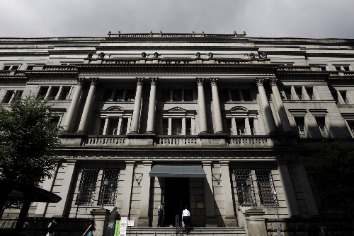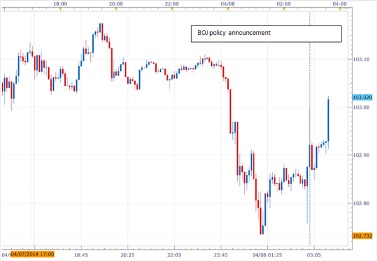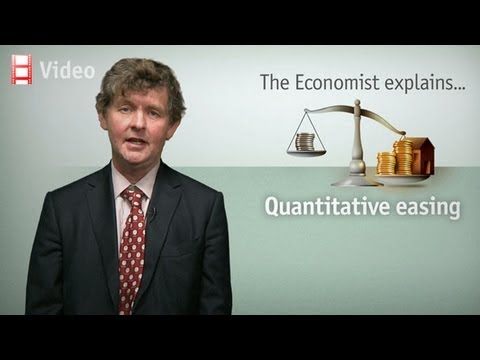Bank Of Japan Rate Decision
Table of Contents Heading
- Preview Of Bank Of Japan (boj) Rate Decision: Usdjpy In Focus
- Usdjpy Tests Bottom Of Symmetrical Triangle After The Bojs Shortened Rate Decision
- When Is The Next Boj Monetary Policy Announcement?
- More On Marketwatch
- Usdjpy Trades Higher After The Boj Compares Coronavirus Pandemic To Great Depression
- Gold Back Above $1,730 Mark, U S. Key Economic Data In Focus; March 15, 2021
- Bank Of Japans Negative Rate Decision Is A Mark Of desperation
The unemployment rate is tipped to rise to 7.7 percent from 7.5 percent a month earlier. “Our new forward guidance is aimed at clarifying our stance that our policy approach is leaning towards additional monetary easing,” BOJ Gov. Haruhiko Kuroda said at a news conference.

You should be aware of all the risks associated with foreign exchange trading and seek advice from an independent financial advisor if you have any doubts. Trading in FX & CFDs related to foreign exchange, commodities, financial indices and other underlying variables, carry a high level of risk and can result in the loss of all of your investment. Before deciding to trade, you should become aware of all the risks associated with FX & CFD trading, and seek advice from an independent and suitably licensed financial advisor. The Bank of Japan will hold an emergency policy meeting today to discuss support measures for financial institutions that boost lending to small firms hit by the COVID-19 pandemic. Traders watch interest rate changes closely as short term interest rates are the primary factor in currency valuation.
“We expect that global economic activity will be restrained until the spread of infections heads towards containment and we project that our economy will stay grim for a while,” he said at an afternoon briefing. For the past year to last month, the BoJ estimates the economy shrank 0.1 percent to 0.4 percent, compared with the previously estimated 0.8-0.9 percent growth. “Given the circumstances, no one expects the latest policy can turn the economy around, and the same can be said about fiscal stimulus,” he said. Hong Kong will release August unemployment numbers; in July, the jobless rate was 6.1 percent. Singapore will see August trade data; in July, non-oil exports were up 1.2 percent on month and 6.0 percent on year, with a trade surplus of SGD3.3 billion. The various loan support programs of the bank will be conducted with a zero interest rate. The Bank of Japan pushed interest rates below zero Friday, after years of keeping them at the lower end of the positive range.
Preview Of Bank Of Japan (boj) Rate Decision: Usdjpy In Focus
Forex (or FX or off-exchange foreign currency futures and options) trading involves substantial risk of loss and is not suitable for every investor. The value of currencies may fluctuate and investors may lose all or more than their original investments. Risks also include, but are not limited to, the potential for changing political and/or economic conditions that may substantially affect the price and/or liquidity of a currency. The impact of seasonal and geopolitical events is already factored into market prices.
“The BOJ will scrutinise the impact of the pandemic for the time being and stand ready to take additional easing steps without hesitation if needed,” he said. – The Bank of Japan will on Tuesday wrap up its monetary policy meeting and then announce its decision on interest rates, highlighting a modest day for Asia-Pacific economic activity. The BoJ is widely expected to keep its benchmark lending rate unchanged at-0.1 percent, although it may introduce other means of stimulus. After years of trying to spark economic growth by bringing down both short-term and long-term interest rates, the Bank of Japan in recent weeks has been moving to lift yields on government bonds, particularly the super-long-dated ones.
Usdjpy Tests Bottom Of Symmetrical Triangle After The Bojs Shortened Rate Decision
Log in to your account now to access today’s opportunity in a huge range of markets. The Bank of Japan’s Policy Board is made up of nine members – the bank’s governor, two deputy governors and six ordinary members – who are appointed by Japan’s cabinet and must be approved by both houses of the National Diet (Japan’s parliament). The bank also has an additional asset purchase programme, through which it buys exchange-traded funds , Japan real estate investment trusts (J-REITs), commercial papers and corporate bonds. We use a range of cookies to give you the best possible browsing experience.
If it wants to bring inflation up to target, then its policies will be designed to increase the supply of money and spending across the economy. If it wants to bring inflation down it will implement policies that are designed to do the opposite. Policies aimed at reducing spending, to lower inflation, may cause the price of stocks, bonds, indices and other securities to fall, and the value of the yen to rise. Conversely, policies designed to stimulate spending to boost inflation – such as quantitative easing – may cause the price of these securities rise, and the value of the yen fall. Bank of Japan Monetary Policy Statement contains the outcome of the BoJ’s decision on asset purchases and commentary about the economic conditions that influenced their decision.
When Is The Next Boj Monetary Policy Announcement?
In 2020, the BoJ eased monetary policy twice, mostly by expanding asset-buying and creating a new facility to deliver funds via financial institutions to companies hit by coronavirus. In theory, the BOJ is supposed to be independent of the government. However, the central bank is infamously known to be easily influenced by politics. Oftentimes, the BOJ adopts policies that coincide with those of the government. For instance, central bankers intervene in the foreign exchange markets when the Japanese yen gets too strong (USDJPY touches or falls below 100.00).

The BoJ also mentioned that it will not change its yield curve control or quantitative easing framework. However, the central bank said will extend the duration of additional purchases of CP and corporate bonds by six months until the end of September 2021, with an upper limit on the amount outstanding of about JPY 20 trillion. In addition, the bank also extended by six months to September 2021 its fund-aid scheme for companies hit by the COVID-19 crisis. In an unexpected move, policymakers added they will begin looking into better ways to achieve its inflation target of 2 percent and release its finding in March. The Bank of Japan is ready to launch more monetary stimulus if COVID-19 in the country threatened to derail a fragile economic recovery, Governor Haruhiko Kuroda said in a speech on Thursday. The remarks came ahead of the central bank’s two-day policy meeting next week, when it will issue fresh quarterly growth forecasts. Kuroda noted that the Japanese economy was picking up, even as an expanded state of emergency declared on Wednesday.
More On Marketwatch
In normal times, such a maneuver might be construed as monetary tightening. But BOJ Governor Haruhiko Kuroda has continually stressed that the bank is very much in easing mode. He said last month that the bank “will not hesitate to add stimulus” if needed, and a number of forecasters expect that he and fellow board members will cut the bank’s short-term policy rate—now at negative 0.1%—on Oct. 31. The Bank of Japan’s monetary policy meeting is a regular session held by the bank’s Policy Board, in which the official interest rates and other monetary policies for the country are chosen in response to the latest economic developments. The Bank of Japan will wrap up its monetary policy meeting on Thursday and then announce its decision on interest rates, highlighting a busy day in Asia-Pacific economic activity. A man walks past an electronic stock board showing Japan’s Nikkei 225 in Tokyo, Friday, Jan. 29, 2016. Japanese stocks swung between gains and losses on Thursday and the yen dived after the country’s central bank introduced a negative rate interest policy to boost the economy after previous stimulus efforts produced indifferent results.
But it revised up the forecast for the fiscal year to March 2022, now estimating growth of 2.8-3.9 percent, against a previous estimate of 1.0-1.3 percent expansion. Even before lifting the 80 trillion yen cap on government bond buying, the BoJ’s purchases were well below the ceiling, Saito noted. The move is “largely symbolic, but it’s better than doing nothing”, Taro Saito, senior economist at NLI Research Institute, told AFP ahead of the decision. New Zealand will provide Q2 numbers for gross domestic product, with forecasts suggesting a decline of 12.8 percent on quarter and 13.3 percent on year.
The objects of the company are all subject matters not forbidden by Companies and Allied Matters Act 1990. To provide Electronic Platform through which clients can choose currencies, commodities, indexes, CFDs and other leveraged financial instruments to trade. After rallying to its three-week highs yesterday, USDJPY gave up some of its gains after BOJ Governor Kuroda expressed willingness to ease policy even more.
Usdjpy Trades Higher After The Boj Compares Coronavirus Pandemic To Great Depression
The consensus among economists and several bank analysts is that the BoJ will hold rates at -0.1% and will make no policy changes as well. This could very well be the position of the BoJ for some time to come. The regulator’s interest rate is used to provide loans to commercial banks. Establishing an interest rate is one of the main tools of the monetary policy used by the Bank of Japan to regulate the strength of its currency. Bank of Japan policy board members come to a consensus on where to set the rate. The yield target for 10-year JGBs was set at 0% in September 2016, meaning the bank is aiming to drive prices to a level where these bonds will offer no return on investment.
Federal Reserve’s policy arm, announced the decision in a brief statement. But for the first time since Jan. 16, when the central bank began releasing such statements after board meetings, it said the decision wasn’t unanimous but merely a majority vote. The BOJ is the first central bank to go through these contortions, because Japan’s institutional investors have been the longest exposed to extraordinarily low bond yields. Germany joined Japan with sub-1% 10-year yields in 2014; both countries are now below zero. Even the U.S. has seen bond yields test historic lows, with potential for further declines, given the latest weakness in economic data and the likelihood that the Federal Reserve will cut interest rates again. To convince markets and the public that it’s committed to easing for the long haul, the BOJ has pledged to keep expanding its balance sheet, which it has done via bond purchases.
Gold Back Above $1,730 Mark, U S. Key Economic Data In Focus; March 15, 2021
Prices of cryptocurrencies are extremely volatile and may be affected by external factors such as financial, regulatory or political events. A higher than expected rate is positive/bullish for the JPY, while a lower than expected rate is negative/bearish for the JPY. Oil prices were lower in the afternoon of Asia trading hours, with international benchmark Brent crude futures down 0.5% to $51.24 per barrel. The Bank of Japan on Friday announced a six-month extension of its special program aimed at easing corporate financing pressures amid the coronavirus pandemic. Meanwhile, the yield target on the 10-year Japan government bond was set at around 0% while the short-term interest target was set to -0.1%.
This then affects the interest rates offered by commercial banks to businesses and consumers, so higher rates can lead to increased saving, and lower borrowing and spending across the economy. A global stock market rally inspired by the Bank of Japan’s decision to lower a key interest rate below zero was belied by anxiety over how much ammunition the world’s central banks have left to fight off deflation. In an outlook report accompanying the latest monetary policy statement, the BOJ said it is maintaining its forecast for inflation to hit 2 percent in the fiscal year 2019/2020. But it now expects core consumer prices to grow 0.8 percent in the fiscal year 2017/2018, lower than the previous projection of 1.1 percent. Risk Disclaimer – By using this web site you agree to its terms and conditions. The unauthorized use of any and all materials is prohibited and restricted by copyright law.
The central bank is widely expected to keep its benchmark lending rate unchanged at -0.1 percent, although it may introduce other means of stimulus. The rate will be cut “further into negative territory if judged as necessary,” the bank said in a statement following a two-day policy meeting that ended Friday. The reduction will cause real interest rates to fall, with the goal of stimulating consumption and investment, Bank of Japan Governor Haruhiko Kuroda said in a news conference in Tokyo Friday.
The bank is widely expected to keep its benchmark lending rate steady at 4.0 percent. The deposit facility rate is called unchanged at 3.25 percent and the lending facility rate is called steady at 4.75 percent. The de facto central bank in Taiwan will conclude its monetary policy meeting and announce its decision on interest rates; the bank is expected to keep its benchmark lending rate steady at 1.125 percent. The Bank of Japan left its key short-term interest rate unchanged at -0.1 percent and maintained the target for the 10-year Japanese government bond yield at around 0 percent during its December meeting by an 8-1 vote.
Bank Of Japan Keeps Rates Flat,
The Bank of Japan on Monday ramped up its emergency monetary easing and cut growth forecasts for the world’s third-largest economy, as the coronavirus pandemic ravages the globe. This file photo taken on March 16, 2020 shows a pedestrian wearing a face mask while walking in front of the Bank of Japan headquarters in Tokyo. – The Bank of Japan on April 27, 2020 ramped up its emergency monetary easing, lifting the cap on its buying of government bonds and increasing purchases of other assets, while cutting its growth forecasts. Australia will release unemployment data for August, with forecasts suggesting the loss of 50,000 jobs following the addition of 114,700 jobs in July.

It is also below the 15-day and 25-day exponential moving averages. Therefore, the pair will likely continue falling as bears target the next support at 103.00.
According to the statistics office, the country added more than 50,000 jobs in December after adding another 80,000 in the previous month. The participation rate also rose from 66.1% to 66.2% in the month. The price of crude oil declined in overnight trading after a sudden increase in US oil inventories. According to the American Petroleum Institute , the number of inventories increased by more than 2.5 million barrels last week. That was higher than the expected drawdown of more than 300k barrels. It is prohibited to use, store, reproduce, display, modify, transmit or distribute the data contained in this website without the explicit prior written permission of Fusion Media and/or the data provider.
Kuroda lately has warned that ultralow yields on super-long-term bonds—say, 20-years and up—could be bad for the economy. “It will have a negative impact on consumer sentiment,” he said on Sept. 19.

